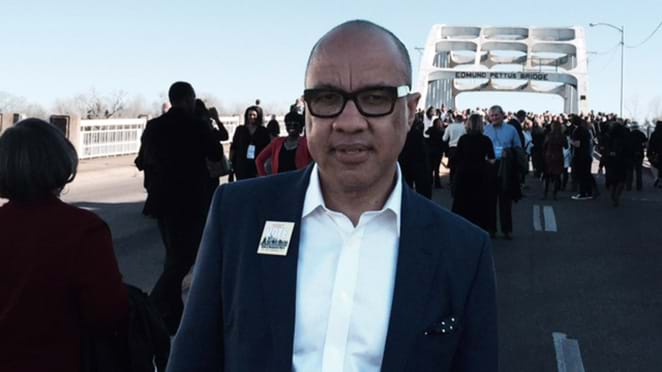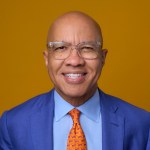
This piece was originally published on Medium.
As I traveled home from last weekend’s celebration in Selma, my heart was full and my spirit renewed.
Staring out the airplane window, I thought about the president of the United States juxtaposed with the Edmund Pettus Bridge. In arguably his finest speech yet—something of a Gettysburg Address for our time—President Obama affirmed that we “can look upon our imperfections and decide that it is within our power to remake this nation to more closely align with our highest ideals.”
I thought about my personal hero John Lewis—the conscience of our Congress—who had invited me to participate with the Faith and Politics Institute in this pilgrimage to a hallowed place for all Americans who believe, in John’s words, that “love will conquer hate” and “hope will conquer fear.”
I thought about my own privilege, and my own overwhelming feeling of grateful obligation. Only in America could a black, working-class kid from East Texas rise to become the president of the Ford Foundation—an institution dedicated to supporting the next generation of social justice leaders and organizations. I could not help but think about how these visionaries—and their ideas—constitute a new movement for civil rights that emerges from the legacy we commemorated this weekend.
But, mostly, I reflected on the larger meaning of our gathering in the first place—on the purpose of anniversaries like this, at all.
On one level, we joined together to honor our history, and those who shaped it.
We retraced the steps of three fateful, far-reaching marches. We visited Brown Chapel, where leaders preached and planned—and the housing projects where foot soldiers for peace and justice stayed and steeled themselves.
Harvard’s President Drew Faust—a historian herself—told me how, as a 17-year-old freshman at Bryn Mawr, she and her boyfriend drove to Selma a half century ago, a secret she kept from her parents their entire lives. Dr. King’s summons, she said all these years later, was simply too powerful to resist.
And yet, on another level, our purpose was to transcend our history—to match reverence with resolve—because, the fact is, our history is anything but over.
Too often, many regard the civil rights movement as the stuff of dusty textbooks. Children study it in school. Its foremost figure stands static—literally chiseled in marble—amidst monuments to long-dead presidents.
Moreover, public figures and commentators adapt and appropriate his words—the language of civil rights—without acknowledging the meaning, and the mission, behind them. We see this manifested in our public debate, as some leaders are quick to quote Dr. King—as if his dream were somehow an accomplishment, not an ongoing aspiration.
To me, this distortion of history ignores the fact that we are yet to overcome the complicated legacy of exclusion and discrimination. As William Faulkner put it, “The past isn’t dead. It isn’t even past.”
Indeed, we see the painful patterns of history repeating themselves day after day. Only hours removed from Saturday’s anniversary, the three top stories in the news featured another young black man killed by a police officer, this time in Wisconsin, a busload of fraternity kids singing songs advocating lynching in Oklahoma, and the fallout from the Justice Department’s report on institutional racism within the police force of Ferguson, Missouri.
And these headlines speak to much larger, longer trend lines. At work are systemic failures explored by authors like Bryan Stevenson in his important memoir, Just Mercy, which explores the endemic phenomenon of wrongfully convicted black men. Michelle Alexander explores a different dimension of the same crisis in The New Jim Crow, illustrating how more black men are incarcerated today than were enslaved on the eve of the Civil War.
In ways immediate and evolving, we still are engaged in, and grappling with, the struggle for authentic equality.
It is true that the battlefront may have moved past the Edmund Pettus Bridge, but the march continues on. We have traded literacy tests for voter ID laws, but voting rights are still under breathless assault. And voting rights are a proxy for so much more. Inequality disenfranchises on a grander scale.
We still are fighting to codify a belief that too many do not practice—that all of us are not only created equal, but also should be regarded as equals, and treated equally, in every aspect of our lives.
This is the America we want. This is the America we all are proud of.
At Selma, President Obama reminded us of our timeless creed, the intent at the center of the American idea: “to form a more perfect union.” This challenge, he said, is “a living thing, a call to action, a roadmap for citizenship and an insistence in the capacity of free men and women to shape our own destiny.”
This is an idea that found voice in President Lincoln, who, in another small town with outsize, enduring significance, “dedicated” the nation to “the unfinished work” of advancing democracy. This is an idea given meaning by generation after generation, who, in President Obama’s perfectly chosen words, “believed that America is a constant work in progress; who believed that loving this country requires more than singing its praises or avoiding uncomfortable truths.”
Marching across that bridge, I was reminded of how much work we have started. But I also was reminded of—and reenergized for—all of the work that remains unfinished.
This week, as I return to my daily obligations, I see them a little differently. While the town of Selma is a thousand miles away—and the courage and grace of March 7, 1965, a lifetime ago—our hopeful march toward justice continues. Writing that very same year, James Baldwin said it best: “History … does not refer merely … to the past. … History is literally present in all that we do.”
More
- Read reflections on Selma from Ford staffers Charlene Caronan and Altaf Rahamatulla.
- Read Darren Walker’s essay “A New Testament of Hope.”
